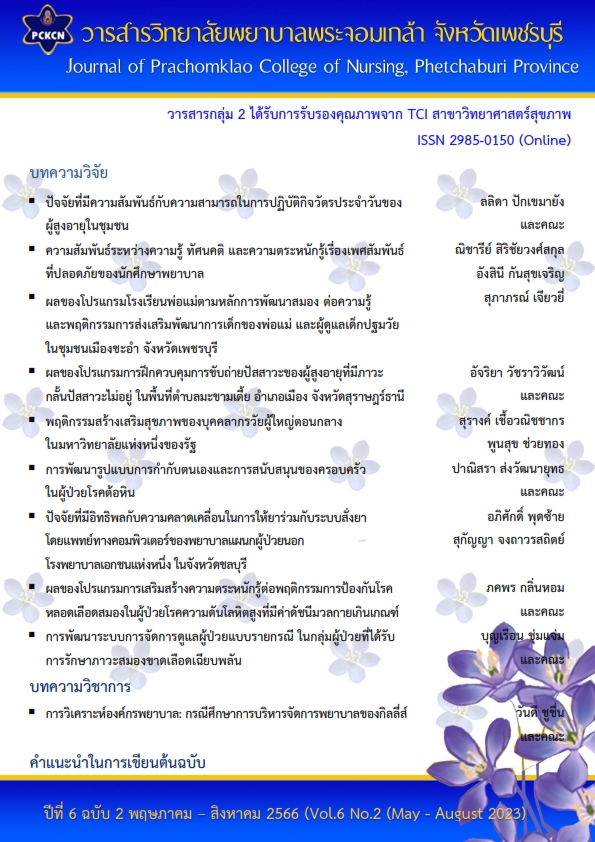ผลของโปรแกรมการเสริมสร้างความตระหนักรู้ต่อพฤติกรรมการป้องกัน โรคหลอดเลือดสมองในผู้ป่วยโรคความดันโลหิตสูงที่มีค่าดัชนีมวลกายเกินเกณฑ์
Main Article Content
บทคัดย่อ
การวิจัยกึ่งทดลองแบบสองกลุ่มวัดก่อนหลังการทดลอง มีวัตถุประสงค์เพื่อศึกษาประสิทธิผลของโปรแกรมการเสริมสร้างความตระหนักรู้ต่อพฤติกรรมการป้องกันโรคหลอดเลือดสมองในผู้ป่วยโรคความดันโลหิตสูงที่มีค่าดัชนีมวลกายเกินเกณฑ์ ในจังหวัดเพชรบุรี กลุ่มตัวอย่างเป็นผู้ป่วยความดันโลหิตสูงที่มีค่าดัชนีมวลกายเกินเกณฑ์ คัดเลือกกลุ่มตัวอย่างโดยการสุ่มอย่างง่าย แบ่งเป็นกลุ่มทดลองที่ได้รับโปรแกรม การเสริมสร้างความตระหนักรู้ต่อพฤติกรรมการป้องกันโรคหลอดเลือดสมอง ระยะเวลา 12 สัปดาห์ จำนวน 39 คน และกลุ่มควบคุม จำนวน 39 คน เก็บรวบรวมข้อมูลโดยใช้แบบสอบถามความรู้เรื่องโรค ความตระหนักรู้ และพฤติกรรมการป้องกันโรคหลอดเลือดสมอง ซึ่งมีค่าความเชื่อมั่นสัมประสิทธิ์แอลฟาของครอนบาคเท่ากับ .85, .86 และ .81 ตามลำดับ วิเคราะห์ข้อมูลโดยใช้สถิติพรรณนา และการทดสอบที ผลการวิจัยพบว่า
1. พฤติกรรมการป้องกันโรคหลอดเลือดสมอง ความรู้เกี่ยวกับโรค และความตระหนักรู้ของผู้ป่วยความดันโลหิตสูงกลุ่มทดลองภายหลังเข้าร่วมโปรแกรม มีคะแนนเฉลี่ยสูงกว่าก่อนการทดลอง อย่างมีนัยสำคัญทางสถิติที่ระดับ .01 (t = 4.66, 13.79 และ 12.30 ตามลำดับ) มีค่าเฉลี่ยความดันโลหิต ค่าดัชนีมวลกายและเส้นรอบเอว ต่ำกว่าก่อนเข้าร่วมโปรแกรม อย่างมีนัยสำคัญทางสถิติที่ระดับ .01 (t = 10.61, 10.15, 1.97 และ 10.26 ตามลำดับ)
2. พฤติกรรมการป้องกันโรคหลอดเลือดสมอง ความรู้เกี่ยวกับโรค และความตระหนักรู้เกี่ยวกับโรคหลอดเลือดสมองกลุ่มทดลองภายหลังเข้าร่วมโปรแกรม มีคะแนนเฉลี่ยสูงกว่ากลุ่มควบคุม อย่างมีนัยสำคัญทางสถิติ ที่ระดับ .01 (t = 5.17, 5.99 และ 10.03 ตามลำดับ) มีค่าเฉลี่ยความดันโลหิต ค่าดัชนีมวลกาย และเส้นรอบเอว ต่ำกว่ากลุ่มควบคุม อย่างมีนัยสำคัญทางสถิติที่ระดับ .01 (t = 2.69, 3.47, 1.69 และ 1.73 ตามลำดับ)
บุคลากรสุขภาพสามารถนำโปรแกรม ไปใช้เป็นแนวทางในการดูแลผู้ป่วยโรคความดันโลหิตสูงที่มีดัชนีมวลกายเกินเกณฑ์ เพื่อส่งเสริมพฤติกรรมป้องกันการเกิดโรคหลอดเลือดสมอง
Downloads
Article Details

อนุญาตภายใต้เงื่อนไข Creative Commons Attribution-NonCommercial-NoDerivatives 4.0 International License.
เนื้อหาและข้อมูลที่เผยแพร่ในวารสารวิทยาลัยพยาบาลพระจอมเกล้า จังหวัดเพชรบุรี ถือเป็นข้อคิดเห็นและความรับผิดชอบของผู้นิพนธ์บทความโดยตรง บทความ เนื้อหา ข้อมูล รูปภาพ ฯลฯ ที่ได้รับการเผยแพร่ในวารสารนี้ ถือเป็นลิขสิทธิ์ของวารสารฯ หากบุคคลหรือหน่วยงานใดต้องการนำทั้งหมดหรือส่วนหนึ่งส่วนใดไปเผยแพร่หรือเพื่อกระทำการใด ๆ จะต้องอ้างอิงวิทยาลัยพยาบาลพระจอมเกล้า จังหวัดเพชรบุรี ทุกครั้ง
เอกสารอ้างอิง
Becker, S. W. (1986). Attitude structure and function. Erlbaum Association.
Bloom, B. S. J. (1971). Taxonomy of education objective, handbook 1: Cognitive domain. David Mokey.
Boonchayanan, P. (2015). Guidelines for the management of overweight and obesity. Moh Chao Ban. (in Thai)
Boontein, P., Saneha, C., Pinyopasakul, W., & Musikthong, J. (2017). The effect of a self-management support program on body mass index, behaviors in controlling metabolic syndrome and risks of cardiovascular disease among police personnel. Journal of The Royal Thai Army Nurses, 18(2), 346-356. (in Thai)
Feske, S. K. (2021). Ischemic stroke. The American Journal of Medicine, 134(12), 1457-1464. https://doi.org/10.1016/j.amjmed.2021.07.027
Little, R. J. A., & Rubin, D. B. (2002). Statistical analysis with missing data (2nd ed.). John Wiley & Sons.
Phipps, M. S., & Cronin, C. A. (2020). Management of acute ischemic stroke. BMJ, 368, Article l6983. https://doi.org/10.1136/bmj.l6983
Saeko, U., & Jitpanya, C. (2015). A study of stroke awareness among patients at risk of stroke in Bangkok Metropolitan. Princess of Naradhiwas University Journal, 6(2), 19-23. (in Thai)
Sangsongrit, N., Pinyopasakul, W., Ayuthya, S. K. N., Sriprasong, S., & Nilanont, Y. (2014). Predictors of medication adherence in ischemic stroke patients. Nursing Journal (Manila), 41(2), 61-71.
Seeruksa, M. (2017). Changing behavior modification for Singburi Hospital officers being overweight. Singburi Hospital Journal, 26(2), 109-120. (in Thai)
Strategy and Planning Division of Office of the Permanent Secretary, Ministry of Public Health. (2019). Public health statistics A.D.2019. Strategy and Planning Division of Office of the Permanent Secretary, Ministry of Public Health. (in Thai)
Strategy and Planning Division, Phetchaburi Provincial Health Office. (2021). Health data center (HDC) of Phetchaburi Provincial Health Office. https://pbi.hdc.moph.go.th/hdc/main/index.php (in Thai)
Thipkratok, S., & Phatisena, T. (2020). Effects of self-management program for health behavior modification, body mass index and waist circumference among village health volunteers with abdominal obesity. Regional Health Promotion Center 9 Journal, 14(34), 210-223. (in Thai)
Tiparat, W., Suwanweala, S., & Sumrit, W. (2017) The effects of self-awareness development program on stroke prevention behaviors among hypertension patients in Muang District, Trang Province. The Southern College Network Journal of Nursing and Public Health, 4(2), 94-107. (in Thai)
Warapongsathorn, T., & Warapongsathorn, S. (2017). Sample size calculation using G*power program. Thailand Journal of Health Promotion and Environmental Health, 41(2), 11-21. (in Thai)
Wauters, A., Oupra, R., & Tanasuwan, P. (2016). Development of a teaching model for prevention of stroke among people at risk in the northern Thai community. The Southern College Network Journal of Nursing and Public Health, 3(2), 100-115. (in Thai)
Weber, M. A., Schiffrin, E. L., White, W. B., Mann, S., Lindholm, L. H., Kenerson, J. G., Flack, J. M., Carter, B. L., Materson, B. J, Ram, C. V. S., Cohen, D. L., Cadet, J., Jean‐Charles, R. R., Taler, S., Kountz, D., Townsend, R. R., Chalmers, J., Ramirez, A. J., Bakris, G. L., Wang, J., & Harrap, S. B. (2014). Clinical practice guidelines for the management of hypertension in the community: A statement by the American Society of Hypertension and the International Society of Hypertension. The Journal of Clinical Hypertension, 16(1), 14-26.
World Stroke Organization. (2020, 9 December). The top 10 causes of death. https://www.who.int/news-room/fact-sheets/detail/the-top-10-causes-of-death#.YhJBDXoc8HO


